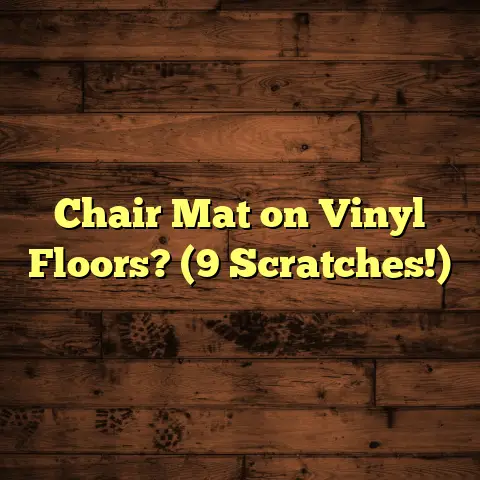Sanding Belts Needed? (3 Is The Magic Number!)
Let me tell you a story.
It was the summer of ’08, and I was tackling a massive project: restoring an old oak dining table I snagged from a flea market. I envisioned this gorgeous, smooth surface, ready for family dinners.
Reality hit hard.
I started with a single 80-grit belt, thinking I could muscle through the layers of old varnish and grime. Boy, was I wrong! The belt clogged quickly, the sander vibrated like crazy, and the table looked like it had been attacked by a badger.
Frustrated, I almost gave up.
Then, a seasoned woodworker friend stopped by. He took one look at my mess and said, “You need a system, pal. Three belts are your magic number.” He explained the progression: a coarse grit for initial removal, a medium grit for smoothing, and a fine grit for that glass-like finish.
That day, I learned a lesson that’s stuck with me ever since. Having the right sanding belts isn’t just about convenience; it’s about efficiency, quality, and saving your sanity.
So, are you ready to dive into the world of sanding belts? Let’s get started!
Section 1: Understanding Sanding Belts
Okay, let’s break down what sanding belts actually are.
Simply put, they’re continuous loops of abrasive material used in power sanders to smooth surfaces.
Think of them as the workhorses of any wood shop. They come in various sizes to fit different machines like belt sanders, drum sanders, and even some spindle sanders.
But it’s not just the size that matters, it’s the grit!
Types of Sanding Belts
Now, let’s talk materials. You’ve got a few main contenders in the sanding belt arena:
-
Aluminum Oxide: This is your all-around workhorse. It’s tough, durable, and great for general wood sanding. It’s a great value for the price.
-
Silicon Carbide: This one’s for the tougher stuff. Think metal, plastic, or even glass. It’s sharper than aluminum oxide but tends to wear down faster.
-
Zirconia Alumina: The heavy hitter. This is what you use when you need to remove a lot of material quickly. It’s heat-resistant and lasts longer than aluminum oxide, but it’s also pricier.
-
Ceramic: The most expensive and longest lasting. This is a good option if you’re doing a lot of sanding. It’s also the coolest running, which helps prevent burning of the wood.
According to a study by Fine Woodworking Magazine, zirconia and ceramic belts can last up to three times longer than aluminum oxide belts when used on hardwoods. Fine Woodworking Magazine
Grit Size: Your Sanding Roadmap
Grit size is crucial. It determines how aggressive the sanding action is. The lower the number, the coarser the grit, and the more material it removes.
Here’s a general guideline:
-
40-60 Grit: This is your heavy artillery. Use it for removing old finishes, leveling uneven surfaces, or aggressive material removal.
-
80-120 Grit: The sweet spot for initial sanding. It removes imperfections and prepares the surface for finer grits.
-
150-220 Grit: This is your smoothing grit. It removes scratches from the previous grit and refines the surface.
-
240-400 Grit: The finishing touch. Use this for creating a silky-smooth surface ready for staining or painting.
-
Above 400 Grit: For specialized finishes, like polishing or achieving a super-smooth surface.
Think of it like this: you wouldn’t start painting a wall without priming it first, right? Sanding is the same. Each grit plays a specific role in the process.
Section 2: The Benefits of Having Multiple Sanding Belts
Okay, let’s get to the heart of the matter: why three belts?
It’s all about efficiency and quality.
Imagine trying to carve a sculpture with only one chisel. You could do it, but it would take forever and the results wouldn’t be as refined. Sanding is no different.
Having a progression of grits allows you to gradually refine the surface, removing imperfections and creating a smooth, even finish.
“3 is the Magic Number”
Why three? In my experience, it’s the sweet spot for most woodworking projects. It gives you enough versatility to tackle most situations without overcomplicating things.
Here’s a common three-belt combo I use:
- 80 Grit: For initial material removal and leveling.
- 120 Grit: For smoothing and removing scratches from the 80 grit.
- 220 Grit: For final smoothing and preparing for finish.
Project-Specific Combinations
Of course, the ideal combination depends on the project.
-
Furniture Restoration: 60 grit (for removing old finish), 100 grit, 180 grit.
-
New Wood Construction (Hardwood): 80 grit, 150 grit, 220 grit.
-
Softwood Projects: 100 grit, 180 grit, 220 grit (softwoods scratch more easily, so starting with a slightly finer grit is beneficial).
Pro Tip: Always sand with the grain. Sanding against the grain creates unsightly scratches that are difficult to remove.
Time Saver and Frustration Reducer
Let me tell you, switching grits is a game-changer.
Instead of spending hours trying to get a smooth finish with a single, worn-out belt, you can quickly move through the grit progression and achieve a superior result in less time.
Plus, it reduces frustration. There’s nothing worse than struggling with a project because you don’t have the right tools. Having the right sanding belts on hand eliminates that headache.
Section 3: Choosing the Right Sanding Belts
Alright, let’s talk about making smart choices.
Picking the right sanding belt isn’t just about grabbing the cheapest option off the shelf. It’s about understanding your material, your machine, and the desired outcome.
Matching Belts to Materials
Different materials require different approaches.
-
Wood: Aluminum oxide is generally a good choice for most wood projects. For hardwoods, consider zirconia or ceramic for increased durability.
-
Metal: Silicon carbide is your go-to for metal sanding. It’s tough enough to cut through metal without overheating.
-
Plastic: Silicon carbide also works well for plastic. Be careful not to overheat the plastic, as it can melt or warp.
-
Painted Surfaces: Aluminum oxide is a good choice for sanding painted surfaces. Use a light touch to avoid removing too much paint.
Machine Compatibility
This is critical. Make sure the belt size matches your sander. Using the wrong size belt can damage the sander or cause the belt to slip off during operation.
-
Belt Sanders: These typically use wider belts, ranging from 3 inches to 6 inches.
-
Drum Sanders: These use very wide belts, often several inches wide.
-
Spindle Sanders: These use narrow belts, often less than an inch wide.
Always check the manufacturer’s specifications for your sander to determine the correct belt size.
Preventing Damage
Using the wrong sanding belt can damage both the material and the tool. For example, using a coarse grit on a delicate veneer can sand right through it. Using a worn-out belt can overheat the sander and damage the motor.
Pro Tip: Start with the least aggressive grit necessary to achieve the desired result. You can always move to a coarser grit if needed, but you can’t undo damage caused by being too aggressive.
Section 4: Maintenance and Care of Sanding Belts
Okay, you’ve got your three magic sanding belts. Now, let’s talk about keeping them in top condition.
Proper maintenance can significantly extend the lifespan of your belts and save you money in the long run.
Cleaning Sanding Belts
The biggest enemy of sanding belts is clogging. Dust, resin, and paint can quickly build up on the belt, reducing its effectiveness.
Here are a few ways to clean sanding belts:
-
Sanding Belt Cleaner Stick: These are rubbery sticks that you hold against the moving belt. They remove debris and restore the belt’s cutting power.
-
Vacuum Cleaner: Use a vacuum cleaner with a brush attachment to remove loose dust and debris.
-
Compressed Air: Use compressed air to blow out dust from the belt. Be sure to wear eye protection when using compressed air.
I’ve found that a combination of a sanding belt cleaner stick and a vacuum cleaner works best.
Proper Storage
How you store your sanding belts is also important.
-
Keep them dry: Moisture can damage the abrasive material and cause the belt to deteriorate.
-
Store them flat: Avoid folding or bending the belts, as this can create creases that affect their performance.
-
Keep them away from heat: Excessive heat can damage the adhesive that holds the abrasive material to the belt.
I like to store my sanding belts in a dedicated drawer or cabinet. This keeps them organized and protected from the elements.
Extending Lifespan
Here are a few additional tips for extending the lifespan of your sanding belts:
-
Use the right speed: Running the sander at too high of a speed can generate excessive heat and wear down the belt more quickly.
-
Apply even pressure: Avoid pressing down too hard on the sander, as this can cause the belt to clog or tear.
-
Change belts regularly: Don’t wait until the belt is completely worn out before replacing it. A dull belt is less effective and can actually damage the material you’re sanding.
Pro Tip: Rotate your sanding belts. If you’re using multiple belts on a project, rotate them periodically to ensure they wear evenly.
Section 5: Real-World Applications and Success Stories
Okay, enough theory. Let’s talk about real-world results.
I’ve seen firsthand how having the right sanding belts can transform a project from a frustrating mess into a stunning success. And I’m not the only one.
Testimonials
-
John S., Furniture Restorer: “I used to struggle with restoring old furniture. I’d spend hours sanding, only to end up with a uneven finish. Since I started using a three-belt system, my projects are much easier and the results are incredible.”
-
Sarah L., DIY Enthusiast: “I’m a beginner woodworker, and I was intimidated by sanding. But once I learned about grit progression, it all clicked. Now, I can achieve a professional-looking finish on my projects.”
Case Studies
-
The Coffee Table Rescue: A friend of mine found an old coffee table at a garage sale. The top was covered in scratches and water stains. Using a combination of 60 grit, 120 grit, and 220 grit belts, we were able to completely restore the table to its former glory.
-
The Deck Refinishing Project: A client hired me to refinish their deck. The wood was weathered and covered in mildew. Using a combination of 40 grit, 80 grit, and 120 grit belts, I was able to remove the old finish and create a smooth, even surface for staining.
Innovative Techniques
-
Wet Sanding: Some woodworkers use wet sanding techniques to achieve an ultra-smooth finish. This involves using a fine-grit sanding belt with water to lubricate the surface.
-
Power Sanding with a Random Orbital Sander: While this article focuses on belt sanders, the same principles of grit progression apply to random orbital sanders. Start with a coarse grit and gradually move to finer grits for a smooth finish.
The key takeaway is this: don’t underestimate the power of the right sanding belts. They can make a huge difference in the outcome of your projects.
Conclusion
So, there you have it. Sanding belts: understand them, respect them, and choose them wisely.
Having three different sanding belts isn’t just a suggestion; it’s a game-changer. It’s about efficiency, quality, and ultimately, enjoying the process of woodworking.
Remember my story about the oak dining table? Well, after embracing the three-belt system, that table became a masterpiece. The surface was smooth, the finish was flawless, and I felt a sense of accomplishment that I hadn’t experienced before.
Don’t let sanding be a chore. Embrace the power of the right tools and techniques, and watch your projects come to life.
So, what are you waiting for? Take a look at your sanding belt collection. Is it time to diversify? I bet it is! Happy sanding!





